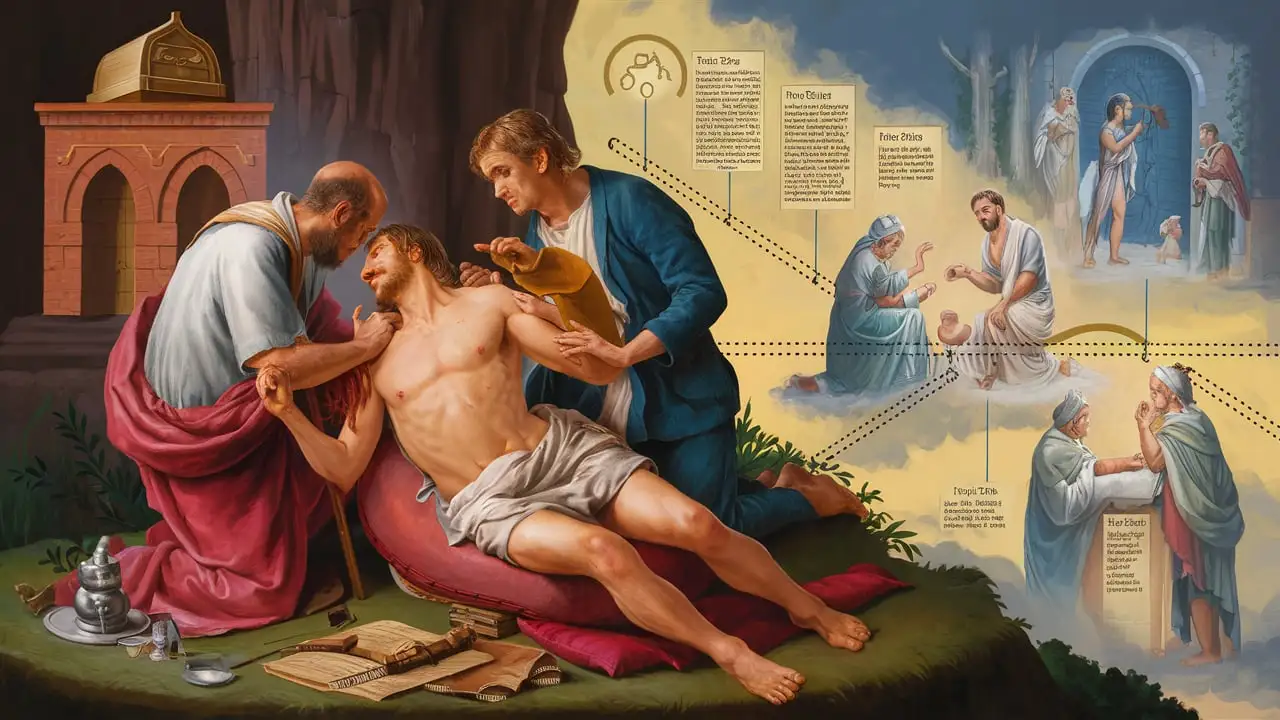Last Updated on September 24, 2024 by Muhammad Ramzan
Circumcision has been a practice of great significance in many cultures throughout history. In the Old Testament, it holds particular importance as a symbol of the covenant between God and His people. This blog post delves into the practice of circumcision in the Old Testament, its theological implications, and how its role has evolved in Christian theology and modern times.
Circumcision in the Old Testament: A Detailed Look
Biblical Origins
Circumcision is first introduced in the Bible in Genesis 17. God commands Abraham to circumcise himself, his household, and his descendants as a sign of their covenant. This command establishes circumcision as a fundamental practice for the Israelites, symbolizing their special relationship with God.
Key Passage: Genesis 17:10-14
“This is my covenant with you and your descendants after you: the covenant you are to keep. Every male among you shall be circumcised. You are to undergo circumcision, and it will be the sign of the covenant between me and you.”
The Abrahamic Covenant
The Abrahamic Covenant is central to understanding the significance of circumcision. God’s promise to Abraham includes:
- Land: The promise of the land of Canaan to Abraham’s descendants.
- Descendants: The assurance of numerous descendants.
- Blessing: The commitment to bless Abraham and his offspring.
Circumcision is the physical sign of this covenant, marking Abraham and his descendants as participants in this divine agreement.
Circumcision as a Symbol
In the Old Testament, circumcision evolved from a mere ritualistic act into a profound symbol of spiritual commitment. It represented:
- Obedience: Adherence to God’s commandments and divine will.
- Purity: A mark of cleanliness and separation from non-Israelite practices.
- Identity: A defining characteristic of the Israelite community, distinguishing them from other nations.
The Covenantal Nature of Circumcision
Theological Significance
Circumcision’s role extends beyond its physical act; it embodies the spiritual bond between God and His people. It signifies:
- Being Set Apart: The Israelites were marked as God’s chosen people, set apart from other nations.
- Enduring Covenant: The covenant established with Abraham was to last for generations, signifying God’s everlasting commitment.
Covenant vs. Ritual
It is crucial to differentiate between the ritualistic and covenantal aspects of circumcision:
- Ritualistic Aspect: The physical act of circumcision.
- Covenantal Aspect: The deeper, spiritual meaning of the covenant it represents.
While the ritual may seem outdated, the covenant’s spiritual significance remains central to understanding its role in the Old Testament.
Circumcision in Christian Theology
New Testament Perspectives
With the advent of Christianity, the role of circumcision underwent significant re-evaluation. Key New Testament passages include:
- Acts 15: The Jerusalem Council’s decision that circumcision is not required for salvation, emphasizing faith in Christ over ritualistic laws.
- Galatians 5: Paul argues that insisting on circumcision for salvation contradicts the gospel of grace.
Shift in Importance
The transition from Old Testament practices to New Testament teachings marked a shift in how circumcision was viewed:
- From Necessity to Symbol: Circumcision was no longer seen as a requirement for salvation but as a cultural and historical practice.
- Focus on Faith: Christian theology emphasized faith in Jesus Christ rather than adherence to Old Testament laws.
Circumcision and Baptism
In Christian theology, baptism has largely replaced circumcision as the primary sign of faith and initiation into the community. Key differences include:
- Symbolism of Baptism: Represents purification, death to sin, and new life in Christ.
- Historical Context: Early Christians saw baptism as a spiritual successor to circumcision, signifying entry into the new covenant through Christ.
Circumcision and Salvation
The New Testament clarifies that salvation comes through faith in Jesus Christ, not through circumcision or other ritualistic practices. This shift underscores:
- Grace Over Law: Salvation is a gift of grace rather than a result of ritual compliance.
- Unified Faith: All believers, regardless of their adherence to Jewish customs, are part of the Christian faith through grace.
Impact of Circumcision Today
Modern Perspectives
In contemporary Christianity, circumcision’s significance varies among denominations:
- Jewish Christians: May continue to observe circumcision as part of their heritage.
- Gentile Christians: Generally view circumcision as a cultural rather than a religious obligation.
Cultural and Ethical Considerations
The practice of circumcision today is debated from ethical and cultural standpoints:
- Medical Perspectives: Some advocate for circumcision for health benefits, while others argue against it due to concerns over bodily autonomy and potential risks.
- Cultural Practices: In various cultures, circumcision continues to hold traditional and ritualistic importance beyond its Biblical origins.
Table: Key Perspectives on Modern Circumcision
| Perspective | Viewpoint |
| Religious | Observed as a tradition or cultural practice. |
| Medical | Debated for potential health benefits versus risks. |
| Ethical | Concerns about consent and bodily autonomy. |
| Cultural | Maintained as part of traditional practices. |
Conclusion
Circumcision has a rich history that spans from its origins in the Old Testament to its role in modern Christian theology and cultural practices. Understanding its evolution helps appreciate its significance not only as a ritual but as a symbol of deeper spiritual commitments.
Final Thoughts
While the physical practice of circumcision may have diminished in its religious necessity, its historical and symbolic importance remains influential. By exploring its Biblical roots and theological implications, we gain insight into its profound role in religious and cultural contexts.
Further Reading
For those interested in delving deeper into the topic, consider exploring:
- Genesis 17: The original covenant command.
- Acts 15: The Jerusalem Council’s decisions.
- Galatians 5: Paul’s discussion on circumcision and grace.
By examining these sources, readers can better understand the complex interplay between religious tradition and theological development.
This blog post provides an in-depth exploration of circumcision’s significance in the Old Testament and its ongoing impact today, reflecting its enduring importance across different contexts.

James Wilson is a renowned biblical scholar and dream expert, dedicated to exploring the spiritual dimensions of dreams. His in-depth knowledge and compassionate approach provide readers with valuable tools to understand and embrace the divine messages revealed in their dreams.










